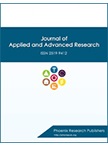Morphological and biochemical response to salinity stress on Setariaitalicaseedlings
DOI:
https://doi.org/10.21839/jaar.2017.v2i4.96Abstract
Salinity is considered as the most important abiotic stress limiting the crop production.The present investigation was made to study the impact of different concentrations of sodium chloride on growth, biochemical constituents and antioxidant enzymes of the seedlings of Setaria italica. Seeds were grown at different concentrations of NaCl [(0,25,50,75, and 100mM] for twenty five days. Salt stress influenced a significant modification in the level of osmolyte accumulation.The accumulation level of osmolytes such as proline, glycine betaine,phenol and antioxidant enzyme such as catalase (CAT) and hydrogen peroxide increased significantly with increasing salt stress conditionwhen compared to the control. A statistically significant decreaseof seed germination percentage,root and shoot length,photosynthetic pigments like chlorophyll a, chlorophyll b and proteins when higher concentration of NaCl added were recorded. From this experiment it was found that the foxtail millet crops can be sustained in optimum (75 mM) salinity condition. It was concluded that these osmolytes play a key role in generating tolerance against salt stress.Downloads
Download data is not yet available.
Published
26-07-2017
Issue
Section
Research Article





 .
.